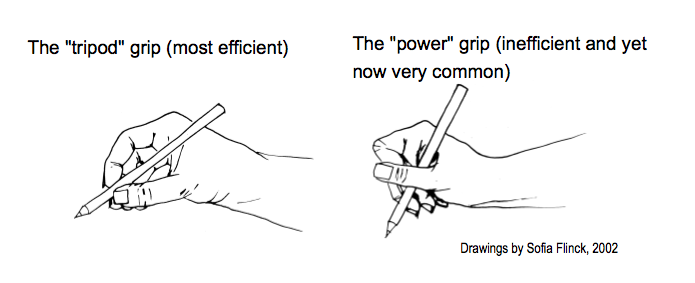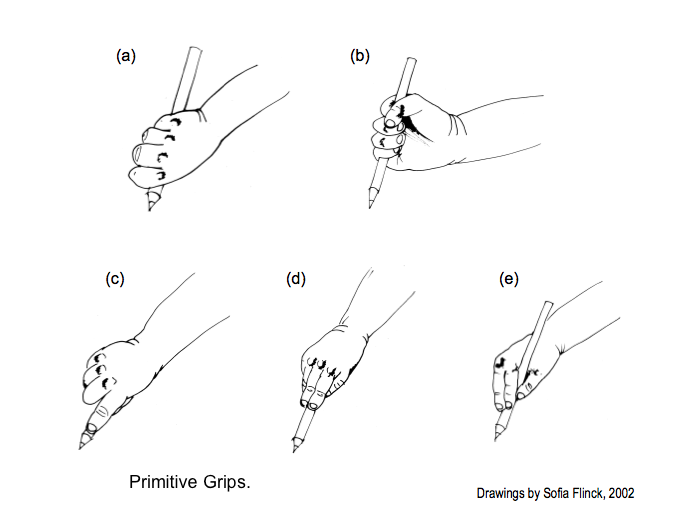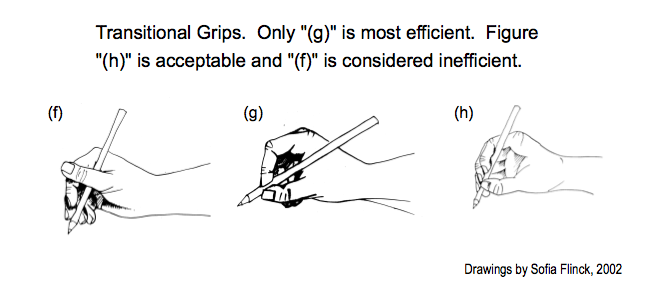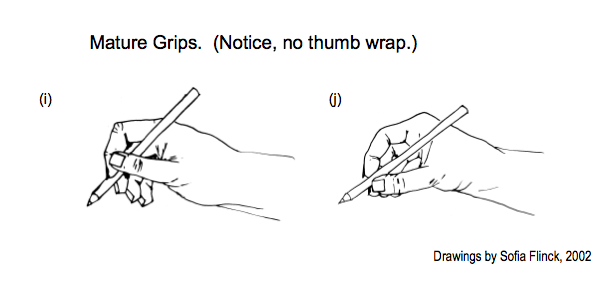Fifteen years ago when I started teaching, it was very rare to find a student struggling with an ineffective or “incorrect” pencil grip. Lately, it seems that nearly every student is using an “incorrect” grip, and it might be causing some problems. Here’s a video that a kindergarten teacher created to teach a “proper” grip. (Please wait a moment for the video to load. It will play automatically.) Thanks to Michelle Green and her Youtube post.
So how does your grip measure up? Why does it matter?
The following information might surprise you, but please note that I am not a specialist. These are only observations and advice from a veteran Language Arts teacher.
In my own observations, students using non-standard pencil grips have non-standard penmanship and less endurance when writing. They are also less comfortable drawing lines and basic shapes when needed. Even underlining text can be difficult because their palms or the larger part of their hands might be in the way.  For example, a student using a “power grip” with a large thumb wrap (thumb extended beyond the pencil and wrapping the fingers) often has to duck his/her head down to a strange angle in order to see his/her own writing because his/her hand is bent around the text as he/she writes. These are often the students who pause repeatedly while writing to shake their hands and moan about the pain in their fingers and wrists. This grip and many other unique grips became so prevalent in my classes that I started to do some research about it. First, it should be said that I now have about 85% of my students using what could be called “incorrect” grips, and when I mention it, not one of them has ever said that a teacher or other adult requested that they try something “better” for mobility and letter formation.
For example, a student using a “power grip” with a large thumb wrap (thumb extended beyond the pencil and wrapping the fingers) often has to duck his/her head down to a strange angle in order to see his/her own writing because his/her hand is bent around the text as he/she writes. These are often the students who pause repeatedly while writing to shake their hands and moan about the pain in their fingers and wrists. This grip and many other unique grips became so prevalent in my classes that I started to do some research about it. First, it should be said that I now have about 85% of my students using what could be called “incorrect” grips, and when I mention it, not one of them has ever said that a teacher or other adult requested that they try something “better” for mobility and letter formation.  They had absolutely no idea that they were holding their pencils in a way that limited their writing ability and caused them pain. I read so much text and have become to many different kinds of handwriting, but the letter formation of nearly 50% of my students comes from invented coping strategies where they simply make up a method to form a character that looks similar to an “a” or “t” but doesn’t follow any logical method for make that character legible to others. I would estimate that 25% of my students have daily moments when they can’t read their own writing, and this often stems from their grip problems.
They had absolutely no idea that they were holding their pencils in a way that limited their writing ability and caused them pain. I read so much text and have become to many different kinds of handwriting, but the letter formation of nearly 50% of my students comes from invented coping strategies where they simply make up a method to form a character that looks similar to an “a” or “t” but doesn’t follow any logical method for make that character legible to others. I would estimate that 25% of my students have daily moments when they can’t read their own writing, and this often stems from their grip problems.
Borrowing from a report by Anne-Sofie Selin, written in 2003, I found details of various researchers. One mentioned that the power grip (or cross thumb grip) impairs the function of the hand or “can reflect tactile impairment of the hand.” Children move from primitive grips to transitional grips (see images).  Eventually, they should settle on the most efficient grips to keep their hand and wrist muscles pain-free. Even with the prevalence of technology for communication, they also want penmanship mature enough to be ready for standard communication with friends and colleagues, certainly throughout the rest of their academic careers.
Eventually, they should settle on the most efficient grips to keep their hand and wrist muscles pain-free. Even with the prevalence of technology for communication, they also want penmanship mature enough to be ready for standard communication with friends and colleagues, certainly throughout the rest of their academic careers. 
I ask my students to consider their grips and how those grips compare to the “efficient” and “inefficient” grips that we teach to children at a young age. They may have strayed down a path leading to difficult penmanship, but they can make a choice to slowly try something better. I only ask them to try another grip 10% of the time with the hope that it will eventually feel more natural and 10% will turn into 20% and so on.
Take a look at your own grip or the grip of your child’s and let me know what you think. I’m curious to learn more about the links between a “proper” pencil grasp and the experience (and quality) of writing by hand.
Have time for a survey?
One thought on “Is Your Pencil Grip Causing Problems?”
Being an English teacher, I will only post comments with standard
spelling, grammar, and punctuation. Please double-check. Thanks.